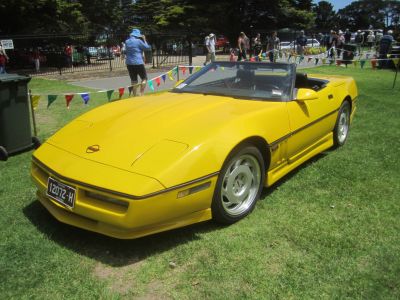 1983 Chevrolet Corvette Coupe (C4) Dimensions, Size & Specs
1983 Chevrolet Corvette Coupe (C4) Dimensions, Size & SpecsMeasurements of the 1983 Chevrolet Corvette Coupe, engineered for optimal performance and comfort
| Dimensions | |
|---|---|
| Length: | 4483-4535 mm176.5-178.5 in14.7-14.9 ft |
| Width: | 1796-1804 mm70.7-71.0 in5.9-5.9 ft |
| Height: | 1177-1202 mm46.3-47.3 in3.9-3.9 ft |
| Ground Clearance: | 120-127 mm4.7-5.0 in0.4-0.4 ft |
| Trunk Capacity: | 357-508 liter12.6-17.9 cu ft |
| Weight Specifications | |
| Curb Weight: | 1435-1555 kg3164-3428 lbs |
| Maximal permitted Weight: | 1760 kg3880 lbs |
| Tire Specifications | |
| Rims Sizes: | 17-inch rims:
|
| Tire Sizes: |
|
The Chevrolet Corvette C4 Coupe, produced between 1984 and 1997, represents a significant evolution in the Corvette lineup, combining sleek design with impressive sports car capabilities. This generation marked considerable advancements in performance, aerodynamics, and driver engagement. Measuring 4535 mm (178.5 inches) in length, the C4 coupe offers a low and wide stance, with a width of 1796 mm (70.7 inches), conveying an aggressive yet balanced presence on the road. The height ranges between 1177 mm to 1202 mm (46.3 to 47.3 inches), contributing to its aerodynamic profile and enhanced downforce.
The curb weight of the Corvette C4 spans from 1501 kg to 1555 kg (approximately 3309 to 3428 lbs), depending on specific trims and configurations, with a maximum weight capacity of 1760 kg (3881 lbs). This balance between weight and power allows the C4 to deliver sharp handling dynamics typical of high-performance coupes. Luggage capacity varies between 357 liters and 507 liters (12.6 to 17.9 cubic feet), providing practical storage space for a sports car.
Tire and wheel specifications further emphasize the Corvette C4's performance focus. Rims range from 11J x 17 inches to 9.5J x 17 inches, 17 inches, and up to 11 x 17 in width, fitted with tire sizes such as 255/45 ZR17, 255/45 R17, 285/40 R17, 315/35 R17, and 275/40 R17. These specifications ensure optimal traction and stability at high speeds.
Overall, the Chevrolet Corvette C4 Coupe stands out as a hallmark of 1980s and 1990s American sports car engineering, blending sharp aesthetics with practical dimensions and performance-oriented specifications. It remains a highly regarded model for enthusiasts seeking a classic yet capable sports coupe.
Discover the standout features that make the 1983 Chevrolet Corvette Coupe a leader in its class
Have a question? Please check our knowledgebase first.
The Chevrolet Corvette Coupe C4 from 1984 to 1997 measures 4535 mm (178.5 inches) in length, 1796 mm (70.7 inches) in width, and ranges from 1177 mm to 1202 mm (46.3 to 47.3 inches) in height. This size made it a sleek, low-profile sports car during its production run, contributing to its aerodynamic efficiency and sporty appearance while maintaining standard coupe proportions.
The curb weight of the Chevrolet Corvette Coupe C4 varies between 1501 kg and 1555 kg (approximately 3310 to 3429 lbs), depending on the model year and equipment. The maximum allowed vehicle weight is 1760 kg (3881 lbs). These weights include the car with standard equipment and necessary fluids but excluding passengers and cargo. The weight balance was optimized for performance and handling characteristic of a sports car.
The luggage capacity of the Chevrolet Corvette Coupe C4 ranges between 357 liters and 507 liters (approximately 12.6 to 17.9 cubic feet). This is relatively generous for a sports coupe, allowing enough space for weekend trips or short vacations. The luggage compartment is designed for optimal use, but due to the sports car's sleek shape, the space is best suited for smaller suitcases and bags rather than large or bulky items.
The rim sizes for the Corvette C4 include 11J x 17 inches for the front and options like 9.5J x 17, 9J x 17, and 11J x 17 inches for the rear, providing a range that supports both performance and style. Tire sizes include 255/45 ZR17, 255/45 R17, 285/40 R17, 315/35 R17, and 275/40 R17. These tire options allowed owners to tailor their car's grip and handling characteristics, whether for everyday driving or sporty performance.
Yes, the Chevrolet Corvette Coupe C4 typically fits into a standard residential garage. With its length of 4535 mm (178.5 inches) and width of 1796 mm (70.7 inches), it is compact enough for most single-car garages, which commonly measure around 3 meters (10 feet) wide and 6 meters (20 feet) deep. Its relatively low height (1177 mm to 1202 mm or 46.3 to 47.3 inches) ensures ample clearance. However, drivers should measure their specific garage dimensions to guarantee a comfortable fit.
The C4 Corvette introduced in 1984 was designed to be more modern and aerodynamic than its predecessor, the C3, which was produced until 1982. The C4 is generally shorter in length but wider and lower, contributing to better stability and handling. The C4's length is 4535 mm compared to the C3’s approximately 4635 mm, but its width of 1796 mm exceeds the C3’s roughly 1762 mm. This shift resulted in a more aggressive, performance-oriented stance, demonstrating how Chevrolet refined the Corvette's design to enhance driving dynamics while shrinking overall footprint.
The Chevrolet Corvette C4 was competitively sized among sports cars of the 1980s and 90s. Its length of 4535 mm (178.5 inches) and width of 1796 mm (70.7 inches) offer a slightly more compact footprint than contemporaries like the Porsche 911 and the Nissan 300ZX, yet it maintains a lower profile height-wise. The luggage space of 357-507 liters is relatively generous compared to rivals, offering better practicality. While not the lightest in its class, its weight and dimensions contributed to a car that balanced straight-line speed with cornering prowess effectively for its era.
The Chevrolet Corvette Coupe C4 is designed as a two-seater sports coupe. Its low height and compact width focus on providing the driver and passenger with a snug, immersive driving environment rather than expansive cabin space. While the driver and passenger have adequate legroom and headroom for a sports car, taller occupants might feel somewhat restricted due to the low roofline. The interior design prioritizes ergonomic controls and sporty styling over spaciousness, maintaining the Corvette’s reputation as a driver-focused machine.
The C4 Corvette marked a major evolution in aerodynamic design compared to earlier generations, offering a more streamlined, wedge-shaped body with flush-mounted glass and smooth contours. This led to a significant drag coefficient improvement, enhancing top speed and fuel efficiency. Its wide stance and lower ride height improved handling stability and cornering capability, aided by advancements in suspension technology introduced during its production. These design choices transformed the C4 into a sharper, more responsive sports car well-suited for both road and track performance.
The Corvette C4’s reduced length compared to the C3 generation and relatively narrow width of 1796 mm (70.7 inches) made it more maneuverable in urban settings. Its low height of approximately 1177-1202 mm (46.3-47.3 inches) gave it a lower center of gravity, enhancing handling but requiring more careful attention over curb height and road obstacles. Though a sports car, many owners found it practical for city driving and parking due to its compact footprint, though the wide rear tires and stiff suspension could require cautious cornering and parking in tight spaces.
Discover similar sized cars.

| Production: | 1986-1990 |
|---|---|
| Model Year: | 1986 |
| Length: | 4483-4535 mm176.5-178.5 in |
| Width: | 1796-1804 mm70.7-71.0 in |
| Height: | 1179-1202 mm46.4-47.3 in |

| Production: | 1976-1983 |
|---|---|
| Model Year: | 1976 |
| Length: | 4580 mm180.3 in |
| Width: | 1850 mm72.8 in |
| Height: | 1270 mm50.0 in |
